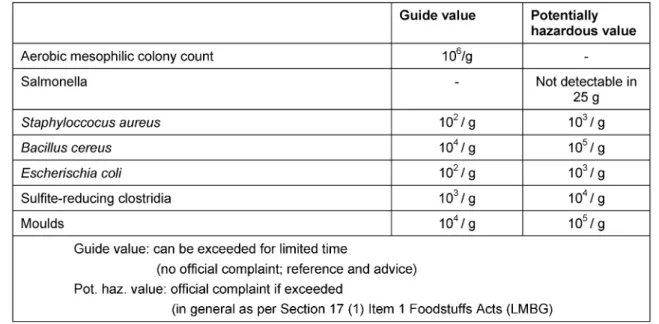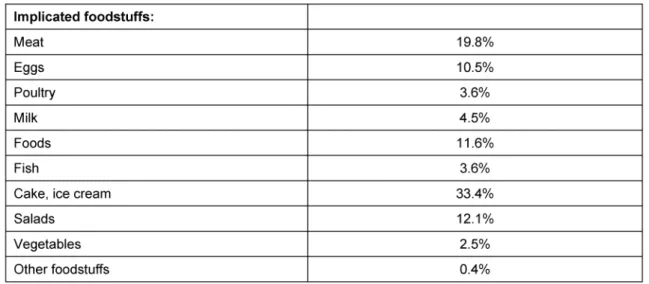Food hygiene on the wards
Lebensmittelhygiene auf den Stationen
Abstract
A problem that is often overlooked or simply not given enough attention:
the food served to patients from the kitchen is not sterile. If food is al-
Walter Steuer
1lowed to stand at room temperature for a long time, both in the case
1 Institute for Hygiene of the Research Institute Hohen- stein, Stuttgart, Germany of food cooked for lunch and of food intended for supper which has
been previously chilled, there is the possibility of massive spore germin- ation or of dangerous toxin formation. Therefore regulations on how to handle food and beverages (e.g. tea) must be set out in the infection control policy, and checks carried out to monitor compliance with the rules relating to temperature checks, duration and type of storage, need for reheating, etc. Making staff aware of the issues involved is of para- mount importance. These include monitoring hygiene standards in the ward kitchen, formulation of a cleaning policy, periodic bacteriological checks (not only of workstations but also of the dishwasher results), whenever possible the use of disposable cloths for working surfaces and equipment, changing cleaning cloths at least once daily and hygienic hand disinfection before and after handing out food.
Foodstuffs brought in by visitors represent a special hygienic and organ- izational problem because in many cases they already have a high baseline microbial count. Visitors must be made aware that, for example, slices of cake left in the patient’s room and often eaten only hours later can pose a risk of infection.
In summary, the following principles of food hygiene must be observed on the wards:
• Maintenance of the cold-hot chain
• Not only reheat food, but ensure it is well heated throughout
• Avoid situations giving rise to spore germination in foodstuffs brought in by visitors
• Cleanliness and minimal contamination of kitchen worktops
• Cleanliness of crockery and kitchen towels
• Do not allow food to stand at room temperature for a long time, in particular desserts and confectionery
• A standard policy must be enforced to define the hygienic status and organization for food distribution for ward kitchens too.
Zusammenfassung
Ein oft übersehenes oder vielleicht einfach nicht ausreichend ernst genommenes Problem: Die Patienten - Mahlzeiten aus der Küche sind nicht steril. Wird das Essen länger stehen gelassen, ist sowohl bei ge- kochtem Mittagessen als auch bei vorher gekühltem Abendessen bei Zimmertemperatur eine massive Aufkeimung oder eine gefährliche Toxinbildung möglich. Essen und Trinken (z.B. Tees) müssen daher in Hygieneplan aufgenommen werden, die Durchführung der Festlegungen in Bezug auf die Temperaturkontrollen, Dauer und Art der Lagerung, Notwendigkeit neuer Erhitzung etc. kontrolliert werden. Die Aufklärung des Personals ist von besonderer Bedeutung. In dem Zusammenhang wird zudem auf die Hygienekontrolle in der Stationsküche hingewiesen.
Die Aufstellung eines Reinigungsplans, fallweise bakteriologische Kon- trolle (nicht nur der Arbeitsplätze, sondern auch des Effekts der Geschir- reinigung), wenn irgend möglich Einmalputztücher für Arbeitsflächen
1/4 GMS Krankenhaushygiene Interdisziplinär 2007, Vol. 2(1), ISSN 1863-5245
Original Contribution
OPEN ACCESS
und Geräte oder der mindestens tägliche Wechsel der Reinigungstexti- lien bzw. der hygienische Händedesinfektion vor und nach der Essens- verteilung.
Von Besuchern mitgebrachte Lebensmittel stellen dabei ein besonderes hygienisches und organisatorisches Problem dar, da in vielen Fällen mit schon erhöhten Ausgangswerten zu rechnen ist. Besucher sind darüber aufzuklären, dass z.B. im Patientenzimmer abgestellte und oft erst nach Stunden verzehrte Tortenstücke zum Hygieneproblem werden können. Zusammenfassend werden auf den Stationen folgende Lebens- mittelhygienische Grundsätze empfohlen:
• Einhaltung der Kühl- und Wärmekette
• Nicht nur Nacherwärmung, sondern Durcherhitzung der Speisen
• Vermeidung der Aufkeimung bei von Besuchern mitgebrachten Le- bensmitteln
• Sauberkeit und minimale Belastung der Arbeitsfläche in der Küche
• Reinheit des Geschirrs und der Küchentextilien
• Keine längere Lagerung von Speisen, insbesondere vom Nachtisch und Patisseriewaren bei Zimmertemperatur
• Hygienischer Status und Organisation der Speisenabgabe muss auch bei Stationsküchen standardisiert werden.
Text
In view of the fact that in the kitchens used for communal catering, microroganisms are often introduced through raw foodstuffs and personnel, several legal measures aimed at infection prevention have been enacted (infec- tion control policies, temperature control regulations for assurance of the cold-hot chain, regular information up- dates for personnel, supervision of working practices, etc.). However, my experiences from infection control in- spections in hospitals, rehabilitation clinics and nursing homes show that the preventive measures intended to assure hygienic provision of foodstuffs are often patchy and poorly observed.
NOTE: The food in the central kitchen is not sterile.
Therefore when food is allowed to stand at room temper- ature for a long time, both in the case of food cooked for lunch and of food intended for supper which has been previously chilled, there is the possibility of massive spore germination or of dangerous toxin formation.
A) Catering for the wards from a central kitchen:
• Formulation of an infection control policy that should be checked and updated at regular intervals.
• Informing staff about the risk of spore germination and toxin formation in foods supplied (often, mistaken views held by auxiliary staff have to be corrected). As borne out by Table 1, more stringent measures are needed for instant products that are not cooked.
• Spot checks of temperature of supplied foods.
• Specification of how long the supplied food, e.g. if the patient is absent, can be kept on the ward (e.g. refri- gerator, ward room, ward kitchen, patient’s room).
• Need for reheating, e.g. in microwave to a core temper- ature of above 65 ° C (caution: fish and meat por- tions).
• Preparation and storage of dispensed teas must also be borne in mind as regards brewing with boiling water and avoidance of long standing time in patient’s or resident’s room.
NOTE: The aim must be to maintain as far as possible the cold or hot chain on the ward.
B) Hygiene checks in the ward kitchen
• Kitchen workstations: regular cleaning is necessary (cleaning policy!) bacteriological spot checks advisable after cleaning (check of efficiency).
• Cleaning cloths: If disposable wipes, the best solution, are not available for the worktops and equipment coming into direct contact with foodstuffs, cleaning cloths (ideal breeding ground thanks to humidity, contamination, room temperature and time). Spot checks showed up to 9,000 cfu/dm²! Such cloths are no longer suitable for cleaning but rather for uniform distribution of any pathogenic microbes present in the kitchen.
• Hygienic hand disinfection is needed after performing any care/nursing activities and before handing out or preparing food in the ward kitchen.
• Refrigerators should be available for storage of food- stuffs on the wards if this is warranted by the hygienic or organizational situation.
• Cleaning crockery: occasional microbiological spot checks, e.g. with Rodac plates, of the cleaned crockery advisable. This is all the more needed if there is visible evidence of inadequate cleaning or drying. The aim aspired to must be not to exceed a maximum count of 50 cfu/dm² forcleancrockery.
2/4 GMS Krankenhaushygiene Interdisziplinär 2007, Vol. 2(1), ISSN 1863-5245
Steuer.: Food hygiene on the wards
Table 1: Microbiological guide and potentially hazardous values for instant products
Table 2: Guide and potentially hazardous values for frozen confectionery with fillings that have not been fully baked and ready to eat without reheating
C) Confectionery brought in by visitors:
As ward staff are well aware of, this presents a special hygienic and organizational problem. As shown in Table 2, already high baseline microbial counts can be expected in the case of inadequately baked fillings.
Often, pieces of cake at left in the patient’s room and eaten only hours later. It is therefore the duty of the nursing staff or ward doctors to make patients, and pos- sibly also visitors, aware of the problems involved. Again, because of their underlying disease or for dietary reasons patients are often not supposed to eat foodstuffs with a very high fat. After all as can be deduced from Table 3, confectionery and ice cream with a score of 33.4% are the chief causes of foodborne disease.
In summary, the following principles of food hygiene must be observed on the wards :
• Maintenance of the cold-hot chain
• Not only reheat food, but ensure it is well heated throughout
• Avoid situations giving rise to spore germination in foodstuffs brought in by visitors, in particular of confec- tionery.
• Cleanliness and minimal contamination of kitchen worktops
• Cleanliness of crockery and kitchen towels
• Do not allow food to stand at room temperature for a long time, in particular desserts and confectionery
• A standard policy must be enforced to define the hy- gienic status and organization for food distribution.
3/4 GMS Krankenhaushygiene Interdisziplinär 2007, Vol. 2(1), ISSN 1863-5245
Steuer.: Food hygiene on the wards
Table 3: Role played in foodborne infections
Curriculum Vitae
Prof. Dr. med. habil. Walter Steuer
Figure1
Figure 1: Walter Steuer
Specialist for Microbiology, Hygiene and Public Health Care.
President of Federal Health Institute of Baden-Wurttem- berg, retired.
Consulting Hygienist for Hospitals, Rehab-Hospitals and Nursing homes.
Walter Steuer was reading medicine in Munich, where he did his doctorate in 1959 and received his licence to practice medicine. As a young doctor he worked in hospitals and runs a doctor’s practice in Stuttgart. From
Stuttgart he moved to the Institute for Hygiene in Tübin- gen, took his Federal Medicinal Test in 1959 and became public health officer at the public health department Böblingen. 1968 he was head of the Medicinal Testing Laboratory of Stuttgart and furthermore President of the Federal Health Authority of Baden-Wurttemberg in 1991.
His retirement has become a real turbulent one: Professor Steuer is still Consultant Hygienist for the Technical Control Board and the Federal Insurance Institution for Employees, he is Director of the Institute for Hygiene of the Research Institute Hohenstein as well as external consultant for hospitals, rehab-hospitals and nursing homes; he is also member of numerous committees, commissions and managing boards. In addition he acts as author and editor and recently added his publications and books to a new important one: „Hygiene in Nursing Care“.
Corresponding author:
Prof. Dr. Walter Steuer
Bildäckerstr. 22, 70619 Stuttgart Walter.steuer@web.de
Please cite as
Steuer W. Food hygiene on the wards. GMS Krankenhaushyg Interdiszip.
2007;2(1):Doc03.
This article is freely available from
http://www.egms.de/en/journals/dgkh/2007-2/dgkh000036.shtml
Copyright
©2007 Steuer. This is an Open Access article distributed under the terms of the Creative Commons Attribution License
(http://creativecommons.org/licenses/by-nc-nd/3.0/deed.en). You are free: to Share — to copy, distribute and transmit the work, provided the original author and source are credited.
4/4 GMS Krankenhaushygiene Interdisziplinär 2007, Vol. 2(1), ISSN 1863-5245
Steuer.: Food hygiene on the wards

